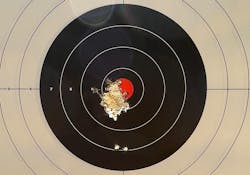FN 509 – Is It In Your Holster?
FN wants to ask, “What’s in your holster?” and if you read that in the voice of a famous actor from a credit card commercial, you’ll understand the underlying message in this article: the FN 509 MRD-LE provides more options and value than comparable contemporary duty pistols. To support that statement we’re going to take a look at the published specifications, our experience testing it (to include daily carry) and how various design features compare to other duty handguns our staff has experienced. Please note that some of the observations made herein are subjective based on those past experiences, but applicable for modern firearms.
Let’s start off taking a look at some of the technical specifications, which of them are “standard” for today’s world and which represent the “latest and greatest.”
The FN 509 MRD-LE is chambered in 9mm, a caliber in use by law enforcement in various parts of North America since at least the 1950s. It’s also the standard NATO handgun caliber in use by military units around the world. Yes, there are those “experts” who say that the only good caliber for self-defense is the .45ACP, but there is a reason the word experts is in quotes and it’s a debate that is well over 120 years old. It will not be resolved by criticizing a modern duty handgun that’s chambered for 9mm. Others claim that the .40S&W is better… or the .357Sig… or the 10mm… or the – well, you get the point. Everyone has their favorite and their opinion, but the 9mm has been in duty service for approximately 130+ years. It’s well tried, tested and proven.
In this chambering, the FN 509 holds 17 rounds in a fully loaded magazine, totaling 18 rounds in a duty loaded weapon (17 in the magazine plus one in the chamber). Optionally, for specialized duty use, there are 24-round magazines available from FN. While some duty handguns hold fewer rounds, the 17-round magazine, for 9mm, seems to be the comfortable maximum capacity and if an officer is carrying a fully loaded weapon with two additional magazines for backup, s/he has over 50 rounds of ammo on the duty belt.
Those 17-round magazines fit flush in the full-length grip frame that has standard picatinny rails for light or laser unit attachment. However, while the grip frame is “full size,” the slide assembly supports a 4” barrel length. In previous years, up until the Army’s most recent handgun weapon system search, a “full size handgun” would have a 4.5”-5” barrel with an appropriately sized slide assembly. Interestingly, many true expert handgun shooters and trainers have long espoused the value of the full-size frame under a “mid-size” slide assembly. The reasons for such are a mix of weapon balance and aesthetics but the end result is the same: a balanced feeling well fed handgun that has sacrificed little sight radius (the distance between the front and rear sights). And speaking of sights…
The optic-friendly three-dot night sights on the 509 MRD-LE are higher/taller than standard sights. They need to be to cowitness through an optic if there is one mounted. Interestingly, the taller sights make using them without the optic even easier. “Equal height, equal light” is a phrase all officers should have heard in training, and certainly every firearms instructor has said a few hundred times in his career. Because these sights are taller, there is more “equal light” on either side of the front sight when a proper sight picture is achieved. In testing, it improved accuracy among our test shooters as compared to other weapons with standard sights. With an optic mounted (our test unit was the Bushnell RXS 250) the fixed sights were still very easy to acquire and line up. Cowitnessing the fixed sights through the RDS also seemed to enhance shooter accuracy. At least one shooter commented on how the “sight picture was actually framed.”
To finish up on the specifications, the FN 509 MRD is a striker fired weapon with a trigger pull quoted as “between 5.5-7.5 pounds.” Most striker fired duty handguns in today’s world have a similar trigger pull and few shooters can tell the difference that a pound of trigger pull makes. This should not be compared to the trigger pull on a double-action weapon or any single action weapon. The focus should be on the benefit of having that trigger pull be near identical every time.
The weapon has no manual safety, an ambidextrous slide release and weighs about 27 ounces. The flat trigger has a trigger-safety built in and is wider than traditional, increasing the tactile sensation and breaking cleanly at 90 degrees (as compared to the line of the slide assembly/barrel). It’s worth noting that one member of our test team had never fired a weapon equipped with a flat trigger before. Not only was he impressed with the crispness of the break but he commented on how different (and good) the flat wide trigger felt as compared to all the curved triggers he’d grown accustomed to across his 30+ years of shooting. After shooting a qualification course he commented on how he felt the flat trigger helped his accuracy by easing control and management of trigger pull and grip on the weapon.
There is a passive firing pin block safety that automatically disengages when the trigger is pulled but is re-engaged once the weapon cycles and returns to battery.
Now let’s talk about some of the subjective items that are equally important: accuracy testing, carry testing and mounting/using that RDS. Our test weapon didn’t come with an RDS provided but the published material says that the weapon is compatible with 10+ red dot sights. As mentioned, we were able to procure a Bushnell RXS 250 and mounting it was pretty easy. The tool for removing the cover plate from the mounting flat was provided. Once it was removed, the right adaptor plate had to be identified or, as in this case, that no adaptor plate was necessary. Once the correct screws were selected (several sets were provided with the FN 509), the RDS was easily installed and tightened down.
On the range, prior to ever turning the RDS on, we had our testers shoot a couple hundred rounds each both slow fire and under time limits, to get a feel for accuracy and handling without using the RDS. Every shot was cowitnessed and the fixed sights were not adjusted. Out of the box it was easy for our test shooters to keep their groupings under 2” at 15 yards in slow fire. Once time limits were added and shooting positions delineated by a qualification course, the groups opened up a bit, but none were over 3”. Satisfied with the fixed sight accuracy and feel of the weapon, familiarized with the controls, our testers turned on the RDS and zeroed it.
As experienced RDS shooters will tell you, there is a different focus in the sight picture when using one and presentation of the weapon changes slightly so that your eye focuses on the red dot rather than the fixed sights officers have been using for decades. When shooting with a red dot sight, the focus is on the target rather than the front sight. That said, our testers found it easiest to find the red dot if they presented the weapon just as they would if they were using the fixed sights, bring the top of the slide up into their plane of vision. Done properly, this comes close to aligning the fixed sights and since the red dot is usually on top of, or close thereto, the front sight in such a position, it was easy to find using this presentation method.
What our testers discovered was that their shooting groups tightened up using the RDS and their times were generally faster. One tester fired a 50-shot group that measured roughly 1.25” wide by 1.5” high. It was one ragged hole about ½” low and left of dead center on the target. All of our testers agreed they’d rather have a duty weapon equipped with an RDS but capable of being shot with the fixed sights should something happen to the power system or structure of the RDS.
Finally, we had an officer who tested carrying the weapon on a daily basis. It’s worth noting that his previous everyday carry handgun was much smaller and with a greatly reduced ammo capacity (6+1 rounds of 9mm). Using an In The Waistband holster (from Tulster holsters) carried in the appendix position, he found the FN 509 MRD-LE comfortable to carry and still concealed. For slightly dressier concealment, that under a sports jacket, he used a Bianchi 126gls holster and it concealed the FN 509 nicely. Finally, for duty wear, he used a BLACKHAWK T-series Overt Level II security holster. All wear and carry testing received positive feedback.
At the end of the testing our staff, both on and off range, agreed that the FN 509 MRD-LE is a well thought out and well-designed handgun, ideal for contemporary law enforcement use. Already adopted by the LAPD, it’ll no doubt find itself into other agency holsters. If your agency isn’t one of those, however, FN does have an Individual Officer Purchase program requiring credentials to participate in but offering excellent pricing options.
For more information about the pistol, visit FNAMERICA.com.
About the Author
Lt. Frank Borelli (ret), Editorial Director
Editorial Director
Lt. Frank Borelli is the Editorial Director for the Officer Media Group. Frank brings 20+ years of writing and editing experience in addition to 40 years of law enforcement operations, administration and training experience to the team.
Frank has had numerous books published which are available on Amazon.com, BarnesAndNoble.com, and other major retail outlets.
If you have any comments or questions, you can contact him via email at [email protected].

